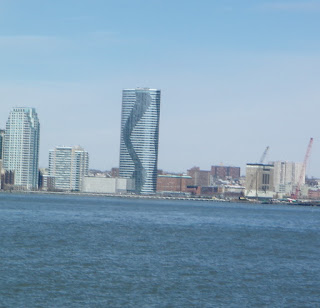Yesterday was a rather pleasant early spring day. There were
more tourists in the vicinity of Battery Park than I anticipated. Is spring
break or some such thing responsible for the teeming masses? Whatever, there
was an overall calm in the relatively speaking—for this time of year—warm air.
Even my two subway rides were rather uneventful—no sense of
menace in either of them. The only panhandler I encountered was a familiar
face. It was the young fellow who—several weeks ago—was insulted by a smug, very annoying
woman who had, in fact, given him a dollar. She expected, though, a little bang
for her buck. The lady wanted him on his merry way and out of her personal
space toot sweet. Happily, he returned her money. His pitch was the same as before,
noting—among other things—that he was embarrassed doing what he was doing and that the price of a breakfast sandwich with coffee was
approximately four dollars—the going rate indeed if one purchases said breakfast
from a street wagon or standard deli.
I provided him half the price of a breakfast and another
passenger in the subway car kicked in as well. At the time I was riding in the
first car and the guy arrived from the adjoining one. This told me that he had
worked the train from last to first. He therefore had no place to go after this final appeal and decided to take a load off his feet. The problem—from his
perspective—was that the train was meandering through a work site at the time—track
replacement—and its operator was periodically laying on its exceptionally loud horn.
“That’s unacceptable!” said the man in palpable agitation as he made an
about-face and hurried away from the horn’s epicenter.
In the beginning there is a train operator entering his cab...and let the good times roll.
And a conductor in the middle of the train who must point at a hanging black-and-white striped board—a zebra board—at each and every station.
Yesterday with spring in the air and with a spring in my step, I decided to go back to the basics. To the point of no return!
This has got to be one of the toughest jobs...
To work in perpetually loud, dreary tunnels with a never-ending stream of unpredictable—and often very angry and sometimes unhinged—straphangers.
In just a few months this marina will be full. For now, it's gone to the birds.
I wonder if this birdbrain appreciates that he or she is in a good place...
I believe the Hudson River sea monster migrates north each spring. The In Search Of... cameras can't be far behind.
Modern architecture just leaves me cold.
Yes, here's the hip eatery that never fails to remind me of my hospital stay and being asked to rate my pain on a scale of one to ten. The higher numbers got me two Percocet tablets instead of one. By the way, what's a communal table?
One Dalmatian.
That's another one out there.
Even grandpa is scrolling and texting these days.
This was the one and only oddball I observed in my journey. He quietly scribbled along for a bit and then—with no prompting—began raving about how the military stole some of his best ideas. I'll take a conspiracy theorist over a Charles Manson-type any day of the week.
And so it is: another ending.
One day there will be the big ending. Maybe somebody is trying to tell us something.
(Photos from the personal collection of Nicholas Nigro)





















































